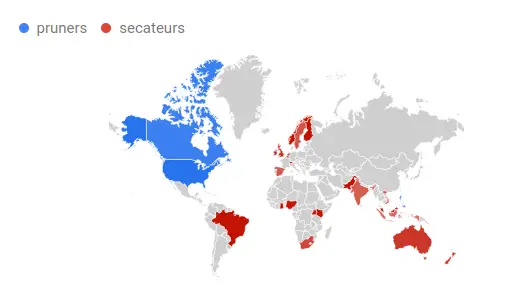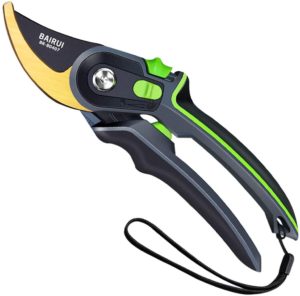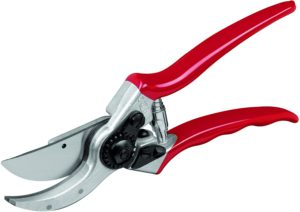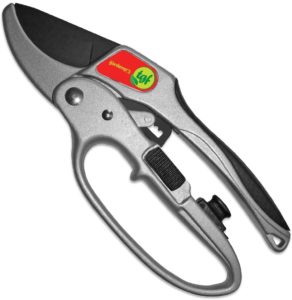We use affiliate links to run our site. When you buy through links on our site, we may earn an affiliate commission, without any added cost to you. Learn more
A pair of pruners or secateurs is a handheld tool that is mainly used to chip away untidy shoots or deadheading flowers. It has a sharp cutting blade and a spring that will open it back up after you make your cut.
You can also use them to harvest crops, and pruning of shrubs. They are essential garden tools for any gardener.
The options for choosing a pruner/secateurs are endless. But if you end up picking the wrong one, they won’t solve the purpose. In this post, we will discuss different types of pruner and their use, and how you choose a pruner depending on your needs.
Pruners vs Secateurs: Is There Any Difference?
There is no difference between A pair of pruners and a pair of secateurs, it means the same garden tool. In American English spoken countries, like America, Canada, etc.
The term to refer to this handheld tool is Pruners, whereas if you live in a country that predominantly uses British English the term is “Secateur”. Some also prefer to call it pruning shears.

In this post, we will use the terms interchangeably.
Types of Pruners:
There are basically 3 types of pruners or secateurs available in the market:
- Bypass pruners
- Anvil pruners
- Ratchet pruners
Bypass Pruners:

Bypass pruners are the most widely used and have the largest range of models. The cutting in a bypass pruner is like a pair of scissors. The blade sharpened on one side crosses over a thicker metal plate to make the cut.
Where to Use A Bypass Pruner:
Bypass pruners are best at making a clean cut. Use it to cut “live” materials like stem branches, flowers, fruits, and tree limbs. It won’t damage the tissue or the woods left on the plant. So the plant will recover fast.
You can expect to cut branches that are similar in diameter to your little finger to up to 25 millimeters (although it depends upon the strength of your hand).
Due to its design, a bypass pruner can be a highly maneuverable tool. The pointed tips enable you to get very close to the congested parts like the trunk of a small tree, the buds of a stem, or the fork in a branch that will be left otherwise.
Sharpen the cutting blade as it dulls over time.
Anvil Pruners:

Cutting in an anvil pruner is like cutting something on a cutting board with a knife. They have a double-edged blade that presses down onto a hardened base plate (anvil). The blade then makes a smash cut with the stem against the anvil jaw or side.
Where to Use An anvil Pruner:
The main use of an anvil secateurs is to cut deadwood. If you use it to cut live materials it would probably smash or damage the remaining part of the plant, and you might have to cut repeatedly.
These are capable of cutting through large tough woody stems just kept them very sharp. The best way to use an anvil pruner is to hold the blade at right angles to the stem.
If your pruning involves a lot of dead stems and limbs then it is best to invest in a good pair of anvil pruners.
Ratchet Pruners:

Ratchet pruners are a good choice if your hands lack strength. They have a distinct hold grip and will assist you in cutting harder or bigger diameter limbs.
Due to their unique mechanism, they maintain the progress through the cut with every press. So you can press, release, and repeat while cutting, till you finish the cut.
Some Ratchet pruners also come with a geared mechanism and or rolling handles to make repetitive cutting much more comfortable.
Where to Use Ratchet Pruners:
- If you have a weaker grip or arthritis, a ratchet pruner can be very useful.
- You can cut much thicker wood with these pruners.
- The downside of these pruners is they are heavier and a bit pricey compared to the other ones.
How to Use Ratchet Pruners:
- Before making a cut release the safety catch.
- Position the blade at the point where you intend to make the cut. Use the upper portions of the blade to snip off thin fresh green stems. For larger cuts move down the blade. This can extend by how far the secateurs open.
- While steadying the upper part of the stem with your other hand, press the handles firmly together to make the cut.
Price of the tool:
The price of the pruners varies according to the complexity of engineering, and the quality of the blade. If you want a tool that will last a lifetime then it’s worth investing in a pruner with a good quality hardened steel blade.
On the other hand, if you don’t plan to maintain your Secateurs, go for a cheaper model that you don’t mind replacing.
How to Choose The Best Pruner For Your Needs:
When choosing your Secateurs there are a number of things to look out for. Here are some of the most important things about a Pruner. Keep them in your mind while choosing one for your garden.
Check the blade specification. The quality of the steel is very important. The harder the steel the longer the blade will last. Some come with a nonsticky coating to make cleaning easier. Ideally, it should also have the option to replace it. This can save you money in the long run.
Make sure the pruners are comfortable in your hand. Some models come in a range of sizes to suit your hand size. Make sure that the grip is good while wearing gloves.
Check the balance of the tool. It is more important than the weight or overall length.
The materials used to make the handles can affect comfort, and weight. Check whether you prefer plastic, plastic-coated, bare metal, or inset with a wooden grip. A plastic handle does not necessarily mean flimsy or less robust. Nowadays, they can be very sturdy.
Look for the safety catch an important safety in the pruner. It closes the blades when the tool is not in use. You should be able to operate a secateurs easily, and ideally with one hand.
Whenever possible choose a brightly colored pruner as it is easier to find them in the mess.
Maintenance and Care For Your Pruners:
Don’t ruin the tool or strain your hands by forcing the cut on larger stems, instead use a tool designed to make larger cuts like long-handled pruners or a pruning saw. Also, avoid using the pruners to cut ties and wires this can ruin the blade. Some pruners have a notch at the base of the blade for cutting wires.
Wipe clean your blades with soapy water after use. If the stains are tough you can also use a scraper to remove them. Use tree sap cleaning solvents to clean the sticky plant sap.
After cleaning dry the blades thoroughly and spray both springs between the handles and the blades with lubricating oil.
You can also use portable sharpening stones to hone the blades. First, wet the stone and then move down the sharpened edge in a circular motion about three or four times. These will also sharpen knives, scissors, and long-handled pruners as well.
A sharpening kit like this also comes with oil to apply before sharpening. This oil removes the tiny shards of metal that are taken off the blade surface while it’s being sharpened.
After prolong use your tools will become misaligned. You can readjust the tool by loosening, then setting the blades, and then re-tightening.
Although this is a very small tool in your garden doing a little research before buying can save a lot of headaches later.
Like the post. Don’t forget to PIN IT.

Amazon and the Amazon logo are trademarks of Amazon.com, Inc, or its affiliates.

Hi there! My name is Prasenjit and I’m an avid gardener and someone who has grown a passion for growing plants. From my hands-on experience, I have learned what works and what doesn’t. Here I share everything I have learned.
